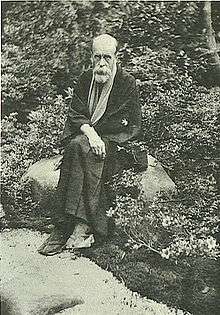Richard Ponsonby-Fane

Richard Arthur Brabazon Ponsonby-Fane (8 January 1878 – 10 December 1937) was a British academic, author, and Japanologist.
Early years

Richard Arthur Brabazon Ponsonby was born at Gravesend on the south bank of the Thames in Kent, England. His boyhood was spent in the family home in London and at his grandfather's Somerset country home, Brympton d'Evercy[1] which he inherited after the deaths of both his grandfather and father. He added "Fane" to his name when Brympton devolved to him in 1916.[2]
Ponsonby was educated at Harrow School.[3]
Career
In 1896, Ponsonby traveled to Cape Town to serve as Private Secretary to the Governor of the British Cape Colony.[4] For the next two decades, his career in the British Empire's colonial governments spanned the globe. He worked closely with a number of colonial leaders as private secretary to the Governor of Natal (1896),[5] to the Governor of Trinidad and Tobago (1898),[5] to the Governor of Ceylon (1900),[5] and to the Governor of Hong Kong (1903).[5] He was re-posted to Natal in 1907; and in 1910, he was private secretary to the Governor of Fiji. Also in 1910 he played a single first-class cricket match for the Marylebone Cricket Club.[6] In 1915-1919, he was re-posted as private secretary to the Governor of Hong Kong.[7]
In addition to his government duties in Hong Kong, he began lecturing at the University of Hong Kong in 1916; and his association with the faculty of the university continued until 1926.[8]
After 1919, Ponsonby-Fane became a permanent resident of Japan, traveling four months of the year to Hong Kong for lectures at the Crown colony's university.[9]
In 1921, when the Japanese Crown Prince visited Hong Kong en route to Europe, Ponsonby-Fane was introduced as his interpreter.[10]
When Emperor Shōwa was enthroned in 1928, he was the only non-Japanese guest who was invited to witness the ceremonies from in front of the palace's Kenreimon gate.[10] In 1930, when HIH Prince Takamatsu and his wife traveled to Europe, Ponsonby-Fane sailed on the same ship; and he was invited to attend all the welcoming receptions for them in England.[10]
In 1932, Ponsonby-Fane built a Japanese-style home in one of the northern suburbs of Kyoto. In the last decades of his life, he was always photographed with a long woolen scarf draped around his shoulders. This unique scarf was said to be hand-knit by Dowager Empress Teimei, the widow of Emperor Taishō; and he highly valued this unique token of personal favour.[11]
Ponsonby-Fane died at home in Kyoto in December 1937.[12]
Selected works
In an overview of writings by and about Richard Ponsonby-Fane, OCLC/WorldCat lists roughly 74 works in 136 publications in 2 languages and 1,443 library holdings.[13]
- This list is not finished; you can help Wikipedia by adding to it.
- The Imperial Family of Japan, 1915
- The Capital and Palace of Heian (Heian-kio oyobi Daidairi), 1924
- The Viciissitudes of Shinto, 1931
- The Nomenclature of the N. Y. K. Fleet, 1931
- Kamo Mioya Shrine, 1934
- Kyoto: the Old Capital of Japan, 794-1869, 1956
- The Imperial House of Japan, 1959
- Sovereiegn and Subject, 1962
- Studies in Shinto and Shrines, 1962
- The Vicissitudes of Shinto, 1963
- Visiting Famous Shrines in Japan, 1964
Honours
- Order of the Rising Sun.[9]
- Order of the Sacred Treasure, 1921.[11]
- University of Hong Kong, Honorary Doctor of Laws, 1926.[7]
See also
Notes
- ↑ "A Biographical sketch of Dr. R. Ponsonby-Fane," Studies in Shinto and Shrines, p. 517.
- ↑ Britton, Dorothy. (1997). "Richard Ponsonby-Fane, A Modern William Adams" in Britain and Japan: Biographical Portraits. p. 193., p. 193, at Google Books
- ↑ Ponsonby-Fane, pp. 517-518.
- ↑ Ponsonby-Fane, p. 518.
- 1 2 3 4 Britton, p. 194., p. 194, at Google Books
- ↑ "Player profile: Richard Ponsonby-Fane". CricketArchive. Retrieved 9 July 2014.
- 1 2 Britton, p. 195., p. 195, at Google Books
- ↑ Ponsonby-Fane, pp. 518-519.
- 1 2 Ponsonby-Fane, p. 519.
- 1 2 3 Ponsonby-Fane, p. 520.
- 1 2 Britton, p. 203., p. 203, at Google Books
- ↑ Ponsonby-Fane, p. 522.
- ↑ WorldCat Identities: Ponsonby-Fane, Richard Arthur Brabazon 1878-1937 ; retrieved 2012-10-29.
References
- Britton, Dorothy. (1997). "Richard Ponsonby-Fane, A Modern William Adams," pp. 190-204 in Britain and Japan: Biographical Portraits (Ian Nish, editor). London: Routledge. ISBN 978-1-873410-62-2
- Fiévé, Nicolas. (2000). Japanese Capitals in Historical Perspective: Place, Power and Memory in Kyoto, Edo and Tokyo. ISBN 9780700714094; OCLC 45325157
- Ponsonby-Fane, Richard Arthur Brabazon. (1962). "A Biographical sketch of Dr. R. Ponsonby-Fane," Studies in Shinto and Shrines. Kyoto: Ponsonby Memorial Society. OCLC 399449